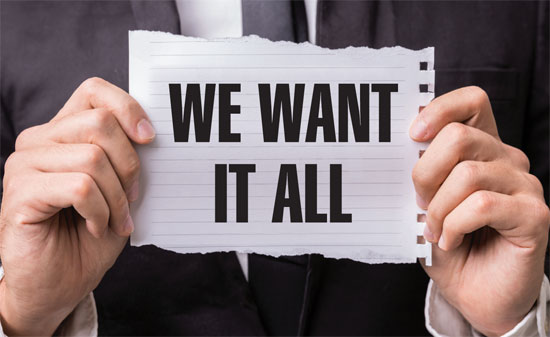Seize the mediation through assertive engagement
We want it all
Every attorney in mediation wants to get the most for the client he or she possibly can, whether that’s expressed in dollars or otherwise – but even with “successful” mediations, most attorneys walk away achieving about 75 to 80 percent of their goal. What you want is 90 percent to 100 percent. In short, you and your client want it all, as did the hero of this narrative:
A grandmother was walking with her adorable grandson along a placid seashore. Suddenly, out of nowhere, a huge wave crashed upon the shore and swept the little boy away. The woman was hysterical in her grief. Falling to her knees she wailed, “God oh God, why have you done this to me? Please give me back my grandson and I promise I will never ask you for anything ever again!” Just then, out of the calm sea, another huge wave crashed upon the shore … and there was her grandson. Stunned but recovering her composure, the woman looked up and said, “He was wearing a hat.” Sure enough, the next wave arrived with his hat.
This woman got it all because she exhibited a mindset that is the exact opposite of what is frequently on display during mediations. Too often, today’s mediations include attorneys who only passively participate. After all, they are burdened with handling the litigation; they’ve prepared their mediation briefs and now it is the mediator’s turn to “make magic.” And so they sit back and let events unfold. Wrong. Instead, they should start with the same approach that enabled the grandmother to get what she wanted; namely, they should seize the mediation through assertive engagement.
More than a nice-sounding phrase
I invite you to consider making a distinct mental shift about how you approach mediations. To be blunt, I suggest you begin with the mindset that you will get more through assertive engagement, and then follow through and act upon it. “Assertive engagement” is a nice-sounding phrase, but what does that mean? A combination of drive and tact comes to mind. It is best illustrated by concrete examples you’ll recognize and can put into practice in the real world.
Your case has been bumping along in litigation and mediation is now on the radar. You’ve done your homework and selected someone you think is a good mediator. The date is set, briefs are prepared, and the day of mediation has arrived. So far, so good, right? Not exactly.
Irrespective of what the mediator may have in mind, you should plan on making a pre-mediation call to the mediator. In fact, best of all, as soon as the mediator and date are selected, you should contact the mediator to arrange for such a call. This serves several purposes. Even before the conversation takes place, you are sending a message to the mediator about your hands-on approach to the mediation. Likely the conversation will take place after you have already submitted your brief. The conversation gives you an opportunity to bring up things which are not in the brief (which may be exchanged with the other side), as well as some things you probably don’t want to put in writing, such as potential client concerns. You can also candidly explore case reservations and/or aspirations, key topics more easily discussed in a two-person telephone conversation than around a conference table in a mediation setting. And the fact that you initiated this telephone call will set a tone that will continue throughout the process.
To facilitate pre-mediation calls and give yourself the opportunity to use other assertive engagement techniques, look for mediators who have a reputation for both working with counsel and encouraging pre-mediation communications.
Parties mediate for a variety of reasons and they have different agendas. One would hope that the dominant motive at the top of the agenda is a good faith intent to settle the case. But there are other reasons for mediation that are not mutually exclusive. Sometimes parties mediate because even if they can’t settle, they believe they will get a lot of “free” discovery. Many times, e.g., in federal court, parties are ordered to some form of alternative dispute resolution. Sometimes it’s company policy to mediate before going to trial. Other times a given mediation session is looked upon as a necessary first session in a series of multiple sessions to come. It is not uncommon for a party to schedule a mediation early on to see if a bargain can be had, or to get a sense of what the range of settlement might someday be.
One of the first things that mediators do is try to ascertain the intent or motives of the parties, as this can have a profound effect on how the mediation proceeds. Even when it becomes clear there is no intent to settle, a good mediator will still try to find a path to settlement or at least the achievement of something of value.
What is the intent?
As important as intent is to the mediator, it is even more important for you to know the intent of your opponent, as it will have a huge impact on how you conduct yourself. How much flexibility should you show? What information will you give? How far will you go with your authority from your client? What will you project to your client?
Many mediation participants never raise intent as an issue and instead simply assume a desire to settle. You may have some idea of your opponent’s intent based upon what has occurred in litigation and prior settlement negotiations, if any. Remove any doubt. Directly ask the mediator about intent at the beginning and again during the mediation as your intuition tells you. And if the mediator says, “I don’t know” or “it’s too early to tell,” ask what the mediator can do to find out and when. Your opponent’s objective should be near the top of your list of essential information about them. Be sure to get the mediator’s take on this, even if you feel you already have a good handle. You’re paying for it.
Reducing the defense arguments
Actively advance your agenda during mediation by coupling your moves in back and forth negotiations with reasons whenever possible and appropriate. Do more than just give the mediator a number to carry back to the other room. Give a reason and ask the mediator to state the reason with the number or the move. For example, you might say that “We are changing our position from $X to $Y in recognition of the potential merit of your argument about ____________.” You have acknowledged their argument, you have paid for it, and now you can cross it off the list of arguments in favor of the other side. You don’t pay for the same real estate twice and you have advanced your agenda by reducing their remaining arguments.
You can affirmatively direct the discussion to issues you want to talk about – your strengths – by using the same technique. When making a small move, you can give a message that goes like this: “We are moving from $X to $Y because we believe in the process, but we are not hearing an answer to our position on __________.” Again, you have kept things going but, more importantly, you have focused a big spotlight on a strong issue for you, advancing your agenda. In either instance, even if people do not like your reason, having a reason for your move is preferable to throwing out a number for no reason other than it is a dance or “just because.”
Use the mediator as a resource
Look upon and utilize the mediator as a resource to get information for you. The mediator will always know things that you don’t because of confidential communications with the other side. While confidential communications are off limits, the impressions and conclusions of the mediator are not – but you have to knock on the door. Go ahead and ask the mediator, based upon what he or she has learned, for the realistic settlement range of the case – and how they arrived at that range. Ask the mediator to get the specifics the other side seems unwilling to provide. Do not allow the other side to dodge with a statement like, “We don’t want to argue over facts, we believe in the strength of our position.” Well, if it is a killer liability issue or such a great defense, what is it? What are the facts or statute or case? Push the mediator to push them on this. In testy circumstances an alert attorney can pull this off with a question for the mediator to ask of her opponent: “Is there something else, anything else, we should know that would influence us to change our position in your favor?”
Cultivate trust
Consciously cultivate a relationship of trust with the mediator, as this will open all kinds of doors for you and make the mediator an even better resource for you. It’s almost impossible to overstate the importance of this. You absolutely want a mediator who has your back vis-a-vis your client and when the mediator is in the other room. A mediator who trusts you to be honest is going to be a much better advocate for your position. Like everyone else, mediators find that when they can trust someone and rely on their word, it is such a welcome breath of fresh air that they naturally gravitate towards that person or their position without necessarily even knowing it. There are many ways to put deposits in the trust account, but in things big and small, it boils down to saying what you mean and doing what you say you will do.
It’s been said that parties make the settlement, and I suppose that is mostly true. More often than not, the heroes I see in mediation are the attorneys who act on behalf of their clients, like the grandmother strolling with her grandson along the seashore. If you are assertively engaged in your mediation like she was and there is a settlement to be had, you will get more than a settlement, you will get the best deal possible. Don’t forget the hat.
Ed Oster

Ed Oster was a trial lawyer for 38 years before becoming a full-time mediator in 2014. As a trial lawyer, he handled the kinds of cases that he focuses on now: bad-faith insurance coverage, ERISA, healthcare industry, life, health and disability, commercial, property and casualty and professional liability. As a neutral with Judicate West, he mediates throughout the United States. He presented the subject of this article at a conference earlier this year, and the submitted article is a modified version of the handout for that presentation. ed@ostermediation.com.
Copyright ©
2026
by the author.
For reprint permission, contact the publisher: Advocate Magazine

